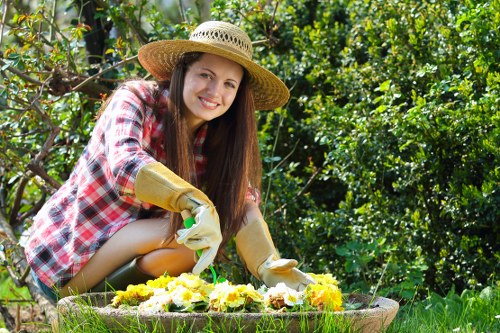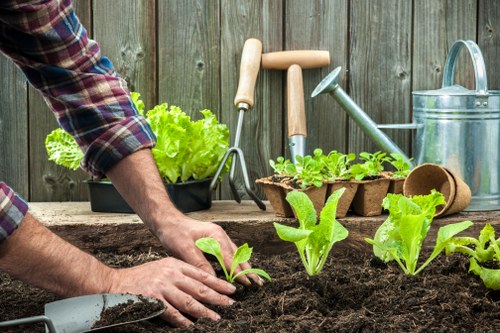Landscape Gardening in Spitalfields: Transforming Urban Spaces
Introduction to Landscape Gardening

Landscape gardening in Spitalfields has become a pivotal aspect of urban living, offering residents a sanctuary amidst the bustling city life. This art of designing and arranging outdoor spaces not only enhances the aesthetic appeal but also contributes to the environmental sustainability of the area.
Spitalfields, known for its vibrant culture and historical significance, provides a unique backdrop for landscape gardening. The blend of old and new architecture creates opportunities for innovative garden designs that reflect the community's diverse heritage.
Engaging in landscape gardening in this area involves understanding the local climate, soil conditions, and the specific needs of urban plants. By tailoring garden plans to suit these factors, gardeners can create thriving green spaces that are both beautiful and functional.
Benefits of Landscape Gardening in Spitalfields

**Enhancing Aesthetic Appeal:** One of the primary benefits of landscape gardening is the transformation of ordinary spaces into visually stunning environments. In Spitalfields, where architectural beauty is prevalent, well-designed gardens complement buildings and streetscapes, creating a harmonious urban landscape.
**Environmental Advantages:** Landscape gardening contributes significantly to environmental health. Gardens improve air quality, reduce urban heat islands, and provide habitats for local wildlife. In a densely populated area like Spitalfields, these green spaces are essential for maintaining ecological balance.
**Social and Community Impact:** Gardens serve as communal spaces where residents can gather, socialize, and engage in outdoor activities. They foster a sense of community and provide a peaceful retreat for relaxation and recreation.
Key Elements of Effective Landscape Gardening

Plant Selection: Choosing the right plants is crucial for the success of any garden. In Spitalfields, it's important to select species that thrive in the local climate and soil conditions. Consider a mix of native plants and ornamental varieties to create a diverse and resilient garden ecosystem.
Design Layout: A well-thought-out layout ensures that the garden is both functional and aesthetically pleasing. Incorporate pathways, seating areas, and focal points to guide visitors through the space and highlight key features.
Maintenance Practices: Regular maintenance is essential to keep the garden healthy and attractive. This includes watering, pruning, weeding, and pest control. Implementing sustainable practices like composting and rainwater harvesting can also enhance garden sustainability.
Popular Garden Styles in Spitalfields

Spitalfields offers a variety of garden styles, each bringing its own charm and character to the urban landscape. Some of the most popular styles include:
- Contemporary Gardens: Featuring sleek lines, minimalistic designs, and a focus on structure, contemporary gardens are perfect for modern homes and buildings.
- Victorian Gardens: Reflecting the historical heritage of Spitalfields, Victorian gardens are lush, ornate, and filled with a variety of flowering plants and intricate layouts.
- Vegetable and Herb Gardens: These functional gardens provide fresh produce and promote sustainable living practices. They are especially popular among urban dwellers looking to grow their own food.
- Rooftop Gardens: Maximizing space in densely built areas, rooftop gardens offer a green retreat with panoramic city views.
Each style can be tailored to fit the specific needs and preferences of the garden owner, making landscape gardening in Spitalfields a personalized and rewarding endeavor.
Choosing the Right Plants for Spitalfields Gardens

Selecting appropriate plants is fundamental to creating a sustainable and thriving garden. In Spitalfields, gardeners should consider:
- Climate Compatibility: Opt for plants that are well-suited to the local climate, ensuring they can withstand the region's weather patterns.
- **Soil Health:** Assess the soil quality and choose plants that can thrive in the existing soil conditions or consider soil amendments to improve fertility and drainage.
- Maintenance Level: Different plants require varying levels of care. Select species that match the gardener's ability to maintain them, balancing beauty with practicality.
- **Environmental Impact:** Incorporate native plants that support local wildlife and contribute to the ecosystem's health.
By carefully selecting plants, gardeners can ensure their landscapes remain vibrant and sustainable throughout the seasons.
Sustainable Practices in Landscape Gardening

Sustainability is a key consideration in modern landscape gardening. Implementing eco-friendly practices not only benefits the environment but also enhances the longevity and resilience of gardens. Some sustainable practices include:
- Rainwater Harvesting: Utilizing rainwater for irrigation reduces dependence on municipal water sources and conserves water.
- **Composting: Recycling organic waste into compost enriches the soil and reduces the need for chemical fertilizers.
- Native Plant Integration: Using native species supports local biodiversity and requires less maintenance compared to non-native plants.
- **Energy-Efficient Lighting:** Incorporating solar-powered lights minimizes energy consumption while providing illumination for evening aesthetics.
Adopting these practices fosters an environmentally responsible approach to landscape gardening, ensuring that gardens contribute positively to the urban ecosystem.
Planning Your Landscape Garden in Spitalfields

Effective landscape gardening begins with meticulous planning. Here are the steps to create a successful garden in Spitalfields:
- Site Assessment: Evaluate the available space, considering factors like sunlight exposure, soil quality, and existing structures.
- **Define Your Goals: Determine the primary purpose of your garden—be it for relaxation, entertainment, growing food, or enhancing property value.
- Design Development: Create a layout that incorporates your goals, balancing functionality with aesthetic appeal. Utilize design tools or consult with a professional landscape designer for guidance.
- **Budget Planning:** Establish a budget that covers all aspects of the garden, including materials, plants, labor, and maintenance costs.
- Implementation: Begin the gardening process, starting with structural elements like paths and seating areas, followed by planting and decorative features.
- **Maintenance Plan: Develop a schedule for regular upkeep to ensure the garden remains healthy and attractive over time.
By following these steps, gardeners can systematically transform their outdoor spaces into flourishing landscapes that meet their personal and communal needs.
Hiring Professional Landscape Gardeners in Spitalfields

While DIY gardening is rewarding, hiring professional landscape gardeners can bring expertise and efficiency to your project. Professionals offer:
- Expert Advice: Knowledgeable about local plant species, soil conditions, and sustainable practices, professionals can provide valuable recommendations tailored to your garden.
- **Design Skills: Experienced designers can create cohesive and aesthetically pleasing layouts that maximize your garden's potential.
- Efficient Execution: Professionals have the tools and manpower to complete projects promptly and to a high standard.
- **Ongoing Maintenance:** Many landscapers offer maintenance services, ensuring your garden remains in pristine condition year-round.
Investing in professional services can save time, reduce stress, and ultimately result in a more beautiful and sustainable garden.
Seasonal Care for Spitalfields Gardens

Maintaining a garden through the changing seasons requires specific care strategies. Here's how to manage your Spitalfields garden throughout the year:
- Spring: Begin by clearing debris, pruning dead branches, and planting new flowers and vegetables. Spring is also the time for applying fertilizers to encourage growth.
- **Summer: Focus on regular watering, especially during dry spells. Implement mulching to retain soil moisture and control weeds. Consider shading plants that may be sensitive to intense sunlight.
- Autumn: Harvest remaining produce, clean up garden beds, and plant bulbs for spring blooms. Protect perennial plants from the upcoming cold by adding mulch or other insulating materials.
- **Winter:** While many plants go dormant, winter is a good time to plan for the next gardening season. Protect delicate plants with coverings and conduct maintenance on tools and equipment.
Adhering to seasonal care routines ensures that your landscape garden remains healthy, vibrant, and ready to flourish each year.
Incorporating Hardscaping Elements

Hardscaping complements the natural elements of a garden, adding structure and functionality. Key hardscaping elements include:
- Paths and Walkways: Define garden areas and guide visitors through different zones with materials like stone, gravel, or paving slabs.
- **Patios and Decks: Provide spaces for outdoor seating and entertainment, enhancing the usability of your garden.
- Feature Walls: Add height and interest, creating visual boundaries or focal points within the garden.
- **Water Features:** Incorporate elements like ponds, fountains, or streams to introduce soothing sounds and attract wildlife.
Integrating these elements thoughtfully can elevate the overall design of your landscape garden, making it both beautiful and functional.
Choosing Sustainable Materials

Sustainability extends beyond plant selection to the materials used in garden construction. Opt for eco-friendly materials such as:
- Recycled Stone: Utilizing reclaimed stone reduces waste and adds unique character to paths and walls.
- **Permeable Pavers: These allow water to infiltrate the ground, promoting groundwater recharge and reducing runoff.
- Bamboo: A renewable resource, bamboo is an excellent choice for fencing and garden structures.
- **Sustainable Wood:** Choose certified sustainable wood for decking and furniture to minimize environmental impact.
Incorporating sustainable materials not only supports environmental stewardship but also enhances the durability and aesthetic of your garden.
Lighting and Ambiance

Proper lighting enhances the beauty and usability of your garden, especially during evening hours. Consider the following lighting options:
- Solar Lights: Eco-friendly and cost-effective, solar lights are easy to install and reduce energy consumption.
- **String Lights: Create a cozy and inviting atmosphere with string lights draped over seating areas or pergolas.
- Spotlights: Highlight key features like sculptures, trees, or water features with strategically placed spotlights.
- **Path Lighting:**u> Illuminate walkways to ensure safety and add a decorative element to your garden paths.
Thoughtfully designed lighting can transform your garden, making it a magical space to enjoy at any time of day.
Maximizing Small Gardens

Spitalfields often features compact urban gardens where space optimization is essential. Strategies to maximize small gardens include:
- Vertical Gardening: Use trellises, wall planters, and vertical structures to grow plants upwards, saving ground space.
- **Container Gardening: Utilize pots, hanging baskets, and other containers to grow flowers, herbs, and vegetables.
- Multi-Functional Furniture: Choose seating that includes storage or can be easily moved to adapt to different needs.
- **Mirrors and Reflective Surfaces:**u> Create the illusion of more space by incorporating mirrors or glossy materials that reflect light and expand visual space.
- Light Color Palette: Use light colors for plants, furniture, and structures to make the area feel more open and airy.
With creative planning and design, small spaces can be transformed into lush and inviting gardens that offer relaxation and beauty.
Embracing Biodiversity

Biodiversity enhances the resilience and beauty of gardens. To foster biodiversity in your Spitalfields garden:
- Diverse Plant Selection: Incorporate a variety of plant species to support different pollinators and wildlife.
- **Wildlife Habitats: Create habitats for birds, bees, butterflies, and other beneficial creatures with birdhouses, bee hotels, and butterfly feeders.
- Native Pollinators: Plant flowers that attract native pollinators, ensuring a balanced ecosystem.
- **Reducing Pesticide Use:**u> Opt for natural pest control methods to protect wildlife and maintain ecological harmony.
Promoting biodiversity not only enriches your garden's ecosystem but also contributes to the overall environmental health of Spitalfields.
Innovative Garden Technologies

Modern technology offers new possibilities for landscape gardening. Innovations that can enhance your Spitalfields garden include:
- Irrigation Systems: Automated drip and sprinkler systems ensure efficient water usage and consistent plant hydration.
- **Smart Lighting: Integrate smart lighting solutions that can be controlled via smartphones for customizable ambiance.
- Garden Sensors: Utilize sensors to monitor soil moisture, temperature, and other environmental factors, optimizing plant care.
- **Sustainable Energy Solutions:**u> Incorporate solar panels or wind turbines to power garden features, reducing reliance on traditional energy sources.
Embracing these technologies can streamline garden maintenance, enhance sustainability, and provide a more interactive gardening experience.
Community Gardens in Spitalfields

Community gardens play a significant role in urban areas like Spitalfields, offering shared spaces for residents to cultivate plants and foster community spirit. Benefits include:
- Social Interaction: Community gardens bring people together, promoting social bonds and collective responsibility.
- **Urban Green Space: They provide much-needed green areas in densely populated regions, contributing to the overall well-being of residents.
- Educational Opportunities: These gardens serve as learning environments for gardening techniques, sustainability practices, and ecological education.
- **Local Food Production:**u> Community gardens can produce fresh, locally grown food, enhancing food security and encouraging healthy eating habits.
Participating in or supporting community gardens can enrich the social and environmental fabric of Spitalfields, making it a greener and more connected place to live.
Final Thoughts on Landscape Gardening in Spitalfields

Landscape gardening in Spitalfields is a dynamic and rewarding endeavor that combines creativity, sustainability, and community engagement. Whether you are a seasoned gardener or a novice, transforming your outdoor space into a beautiful and functional garden can significantly enhance your quality of life.
By understanding the unique aspects of urban gardening, selecting appropriate plants, and incorporating sustainable practices, you can create a thriving green oasis amidst the city's vibrant landscape.
**Ready to transform your space? Contact us today to start your landscape gardening journey in Spitalfields and bring your vision to life.

